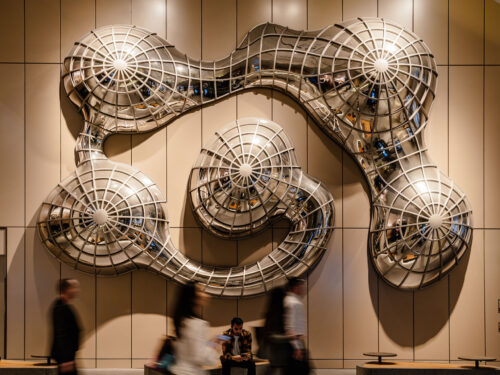
In Claire Healy and Sean Cordeiro’s We Hunt Mammoth, 2015, the entirety of a Honda car has been broken down to 121 individual components, each part tied in jute and bamboo, a traditional Japanese method of packaging. Hanging on the wall, the work evinces a distinctly votive quality, as if this deconstructed vehicle is offered up in an obscure religious ceremony.
The work conflates materials and modern and ancient traditions of making, from the car itself – a gleaming contemporary consumer object which arrives at the end of a sophisticated production line with the assistance of highly trained technicians and programmed robots – to the exacting hand that repackages the now disassembled automobile. The title is suggestive of a science fiction narrative, one in which man-made objects become a source of spiritual resonance similar to the kind of religious meanings that the hunt holds for traditional societies. Untangling these aspects of We Hunt Mammoth might well prompt a momentary sense of estrangement or bewilderment in the viewer.
This kind of conceptual play is typical of Healy and Cordeiro’s practice. The duo have long been fascinated by the way in which objects can not only speak to what they are – furniture, lego, bottle tops, entire houses and earth- moving vehicles – but also to the way in which these objects and materials can be recontextualised to another kind of narrative, one that makes comment both on their function and their potential symbolic meanings.
Mondo Futuro, 2017, utilises a vintage retro-engineered Mercedes 220S, a car from the mid-1950s, which runs not on petrol or diesel but on a bio fuel derived from a process in which gas is extracted from heated wood. Although a bio fuel is perhaps more sustainable than petroleum, the car requires wood chips to run, negating whatever advantage this technology offers. To achieve the kind of comfort and convenience a car offers, a sacrifice must be made. Marked with iconic motifs derived from the Swabian Alemannic Fassnacht and European Wilder Mann traditions, which eulogise the forest as a symbol of semi-mystical, pagan self-realisation, Mondo Futuro evokes ambivalence about technology and about the environment, at once a marvel, but also a profound liability, and what the artists have described as being symbolic of the complex relationship we have with technology and the environment.
The title of the work references the ‘Mondo’ films of the 1960s, pseudo documentaries that purported to depict the world in sensational terms, but were instead fictions derived from the activities of an array of complicit participants and unwitting subjects. In essence, this notion of the ‘world’
is entirely speculative, constructed from a deliberate, if entertaining, misreading that renders documentary reality as a kind of fiction. In Mondo Futuro and We Hunt Mammoth, Healy and Cordeiro offer a glimpse of a tomorrow, one that is already evident today – a world where fragments of reality are recombined into an alternative view of a connected contemporary world, glorious in its contradictions, yet persuasive in its truth.
Andrew Frost












